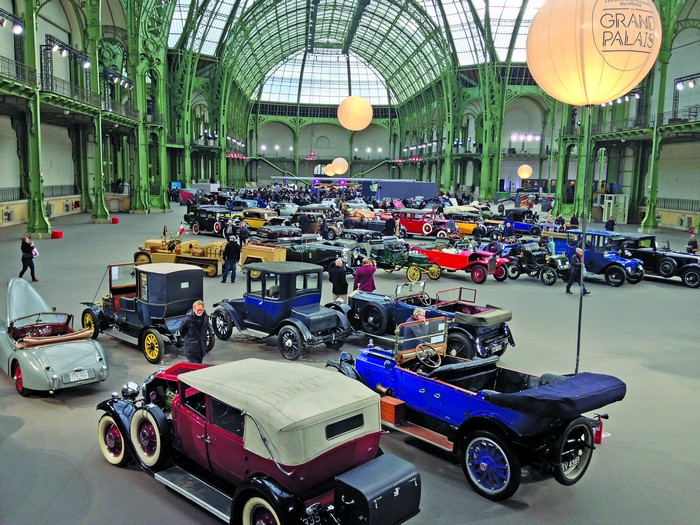
Just weeks ago I was toodling through the Arizona desert, sneaking away from the auctions for a quick drive to Sedona in a lovely dark blue Aston Martin V8 Vantage.
I was seeking a brief respite from the ceaseless shattering of world records at the auctions being held, where one high sale after another was recorded. And it wasn’t just Gullwings and Ferrari Cal Spyders causing skyrockets — lesser cars, such as Alfa Duettos ($50,600/Gooding) and Fiat 124 Spiders ($48,300/Bonhams), rang the bell as well. Those who sold these cars two years ago at what was then full price plus suddenly felt market-stupid, and those who had held on had become automotive Einsteins.
This issue contains a complete report on the Arizona extravaganza, with SCM experts providing a blow-by-blow account and analysis of every auction. Suffice it to say, the overall results of $225m, up $40m from last year’s $185m, offer an indication of what you can expect inside. But the volcanic eruption of collector-car prices is not limited to one desert, one state, or one continent.
I reflected on this a few days later when attending Bonhams’ Les Grandes Marques Du Monde au Grand Palais sale as a ratty Espada (un porc peur?) estimated at $21,100–$33,500 sold all-in at $74,774. Mon Dieu, Seigneur! A tired-but-complete one-owner Aston Martin DB4 Series V Vantage cabriolet was estimated at $469,000–$603,000. SCM contributor Steve Serio and his cohort, the irascible Peter Brotman, agreed that even at the high end of the estimate it was a reasonable buy. Result? Sold at $1,090,453 service compris.
It was no different the next night at Artcurial, where after a 30-minute Can Can recital (yes, really — after all, we were in Paris), the prices were higher than the kicks of the performers. Unloved in the U.S., but in perfect condition, a 1971 Citroën SM coupe estimated at $80,400–$134,000 sold for $170,652. That’s big money, especially for a ride in which the French chassis is always at war with the Italian powerplant.
Nice to be back
It’s been almost a decade since I’ve attended Rétromobile. So it was with some degree of trepidation that I made the transition from Arizona’s deep-fat-fried turkey drumsticks to entrecôte with frites.
My biggest gastronomical surprise? The French, the acknowledged grand masters of things vin, served us the gamut, from vin de maison to Premier cru classé, in equally small glasses.
Coming from Oregon, where the local Pinot Noir snobs won’t touch any goblet smaller than a Big Gulp, and without the perfectly shaped lip that puts the red stuff onto exactly the right spot on your tongue, I was stunned. I asked a waiter if they had any “big glasses.” He replied, “You must be an American. You are confusing the big taste with the big glass.”
SCM’s participation at Rétro has long been the opening night party for subscribers at the Café Le Jambon a la Broche. During the past decade, longtime SCM Etceterini editor Donald Osborne has manned this Bastille and hosted the event. Under his direction, it has grown to be a “must-do” event for SCMers, most of them Americans, and this year was no different. A list of the attendees will appear in our next issue.
Sponsored by Donald’s Automotive Evaluation Services and Ed Fallon’s Cave Creek Classics, there were more than 100 SCMers in attendance. SCM contributors Ken Gross, Robert Cumberford and Martin Emmison were there, and my daughter and SCM Blogger Alex dutifully recorded and transmitted the goings-on, while my wife, Wendie, made sure everything flowed smoothly.
Part of what makes Rétromobile unique is the blend of dealer displays with interesting merchandise on offer, plus a delectable supply of parts, accessories, memorabilia and automotive art. Need a voltage regulator for your Delage? Or some taillight lenses for your Isotta? Chances are you will find them here.
Are we just richer?
Reflecting on the Bonhams and Artcurial sales, prices were strong across the board. Both companies achieved new high totals, Bonhams at $15.7m, up from its previous Rétromobile record of $14.5m in 2009, and Artcurial at $19.6m, besting last year’s $17.7m high-water mark.
Is this upsurge because collectors have suddenly become more affluent? I don’t think so. If you attend a club meeting of an affordable sports car such as a Triumph, MG or Fiat, you find the same longtime enthusiasts, making the same kind of money, caring for their single special car. The rising prices don’t mean they have more to spend on their cars; they have always worked on a limited budget, necessitating frugality — which explains much of the do-it-yourself maintenance and “custom” restorations you see.
I think what is happening in the market is that new money continues to flow in, and these fresh players view $50,000 as an entry-level price. They have only experienced the collector-car market when it has been rising, and with so many other forms of investment flat, cars seem like part of the 1849 Gold Rush. “We’ve been right for three years, how could this ever change?”
I spoke briefly with noted restorer and longtime SCMer Paul Russell about the market, and we both agreed that first, a car is worth what someone pays for it. For instance, since a bidder decided to spend $411,068 for the 1972 Daytona coupe at Artcurial, estimated at $294,800–$348,400, it doesn’t mean that he was a fool. It means that the amount he spent was within his budget, and that he felt the number was reasonable, even if ahead of what the current market might be. In fact, he is now setting the current market.
Paul and I also talked about the long dry spell that collectible cars have endured, reaching back to the last real peak in 1989. It may be that after 24 years in the doldrums, the world at large has rediscovered cars as reasonable investments and items to value, and has decided they have simply been too cheap. And maybe they have been. ?